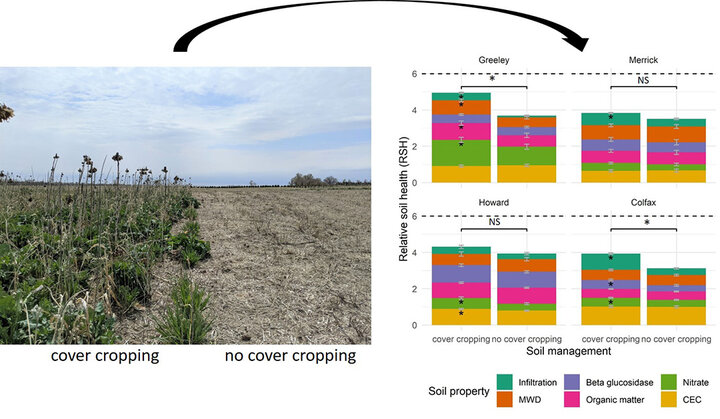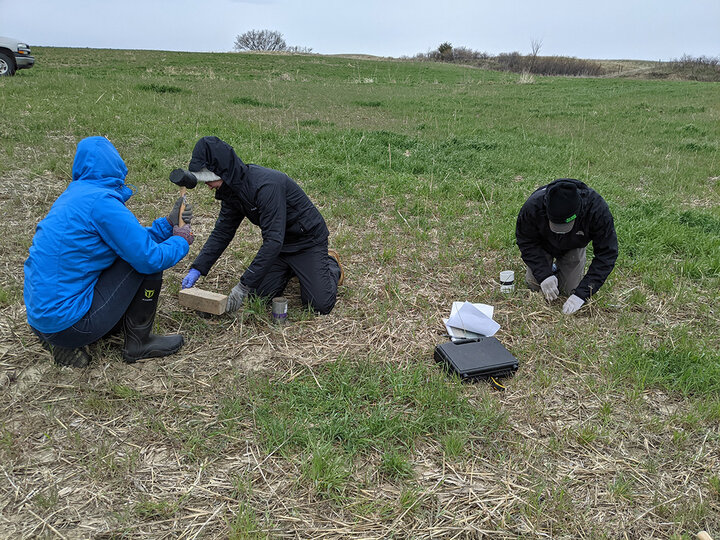There are an increasing number of initiatives — such as education efforts and incentive programs — promoting cover crops as a way to meet soil health goals. However, assessing the “success” of cover crops on farms can be challenging. Part of the challenge with evaluating the effects of cover crops are due to inherent sources of soil variability, differences in measurement approaches, properties measured and more.
In spite of such variability and differences, it is important to track how changes in management practices (for example, from winter bare to cover cropped soil) are improving the soil. Various soil sampling strategies can be used to determine what these improvements might be. You may also be interested in the relationship between soil health and farm outcomes such as cash crop yield, to be able to answer questions such as:
- What are the realistic or attainable gains in soil health with cover crops?
- Are sampling strategies for soil heath assessments the same as those used for standard soil testing?
- How are cover crop-related gains in soil health related to grain yield?
Our recently published work from data generated by the USDA-NRCS Nebraska Soil Health Initiative helps shed light on common questions related to these topics. In particular, we highlight the importance of reference soils, linkages between soil health and cash crop yield, and sampling strategies.
Take Home Message #1: Comparing soil health indicators from “reference” soils, in addition to soil health indicators from improved (cover crop) areas and control/check (no cover crop) areas, increases understanding of management impacts.
One way to quantify whether cover crops are returning the most soil health-related benefits is by comparing soil metrics with benchmark values from a theoretical “reference state”. These reference sites are meant to be within a system that includes all four pillars of soil health management (increased diversity, year-round cover and living roots, and reduced soil disturbance in the long-term).
The idea of a reference state is not new. It has been applied for many years to understand the health of rangelands. But the application of a reference state in agricultural soil health research is still being developed. For example, UNL-NRCS collaborative work is developing the concept of Soil Health Gap and the Soil Health Institute is adopting the concept of Soil Health Targets to evaluate soil health among soils with similar potential.
Following the same idea, we selected sites representing perennial grassland as reference states. These identified reference sites were used to determine soil health benchmarks of the four nearby (
In the following figure, we looked at the “relative soil health index” values for multiple soil physical (infiltration, aggregate stability), chemical (nitrate, CEC, organic matter), and biological (enzyme activity) properties. We observed that three years of cover cropping into corn-soybean rotation closed the gap in soil health — the proximity of relative soil health index values to the reference soil values (Figure 1) — by 55%, 28%, 17%, and 14% in Greeley, Colfax, Howard and Merrick study locations, respectively.

The four on-farm sites were all testing cover crop versus no cover crop; however, the magnitude of the cover crop management response was not the same. Larger gains in soil health were observed when cropland was under long-term (over 10 years) no-tillage and when cover crop management practices, such as species selection and planting/termination dates, resulted in cover crop spring biomass accumulation of over 2,500 lbs per acre. Obtaining larger gains in soil health using cover crops in Nebraska requires a re-think of the current approaches to cover cropping to maximize cover crop ecosystem services in addition to more co-creation of research with farmer partners.
Take Home Message #2: Soil health indicators are not the end to themselves.
What is the return on investment in soil health? To answer this question, better linkages between soil health indicators and farm outcomes are needed. Because crop yield is an important part of the farm’s profitability and was estimated in our on-farm plots, we analyzed the relationship between relative soil health and corn/soybean yields.
Notably, gains in soil health showed some association with increased cash crop yields, but the relationship was somewhat weak or neutral. A similar study conducted in on-farm corn fields in Texas showed measurements from the Haney Soil Health Tool were weakly related to grain quality (protein and oil content). Another study in Missouri emphasized the importance of better understanding the relationship between soil health indicators and agronomic outcomes as well as the legacy of past field management decisions.
Findings from this and other on-farm research, including cover crop studies that are part of the Nebraska Extension On-Farm Research Network, do not consistently confirm the optimistic predictions about the investment in soil health returning the most benefits (higher ROI than check treatment). No change in or decreased yields are reported by many experienced farmers using soil health management practices. We believe further research could better account for full economic assessments of practices, as the Soil Health Institute has recently explored in detail in Nebraska and other states. Additionally future research could approach soil health as a fine-tuning of the main factors affecting crop yield potential — water, nutrients, weeds and diseases — rather than numbers of attainable crop yield. This was recently suggested by researchers from Washington State University; a detailed explanation is available of the fine tuning of nutrients and water availability with soil health improvements.
Take Home Message #3: Bringing soil health research to the on-farm research scale requires careful consideration of the role of soil sampling approaches.

Assessing soil health reliably and consistently starts with appropriate soil sampling. In our study, we looked at strategies regarding the minimum number of water infiltration tests needed to reduce field measurement uncertainties from a spatial and temporal scale standpoint. Water infiltration measurement points within a treatment replication were identified based on soil types according to SSURGO map unit. Our results showed sampling intensity needs to be sufficiently high (five random measurements per sampling point per soil type, sampling every four to five acres, compared to one or two measurements per sampling point) to accurately represent cover crop impacts on this soil property at the farm field scale.
When considering sampling intensity and soil health analysis on farm fields, there is certainly a trade-off between accuracy and costs. Collecting more samples from the same field increases accuracy but also increases expenses and is time consuming. Scaling up (for example, field versus watershed scale) soil health research certainly requires close consideration of sampling approaches and their respective accuracy and cost trade-offs.
For more details on the research findings of this work, refer to the published article available here:
Krupek, F. S., Mizero, S. M., Redfearn, D., & Basche, A. (2022). Assessing how cover crops close the soil health gap in on-farm experiments. Agricultural & Environmental Letters, 7, e20088. https://doi.org/10.1002/ael2.20088
Acknowledgments
The authors would like to thank the Natural Resources Conservation Service (USDA-NRCS) and Robert B. Daugherty Water for Food Global Institute (DWFI) for funding support.
